Learn how to make a crowd-pleasing loaded hummus platter to serve as an easy appetizer, snack, or even a light lunch! This post has ton of ideas for selecting veggies and other toppings, presenting your plate in a beautiful way, and making the creamiest homemade hummus recipe. If you’re wondering what to put on a hummus plate for a party, you’re in the right place!
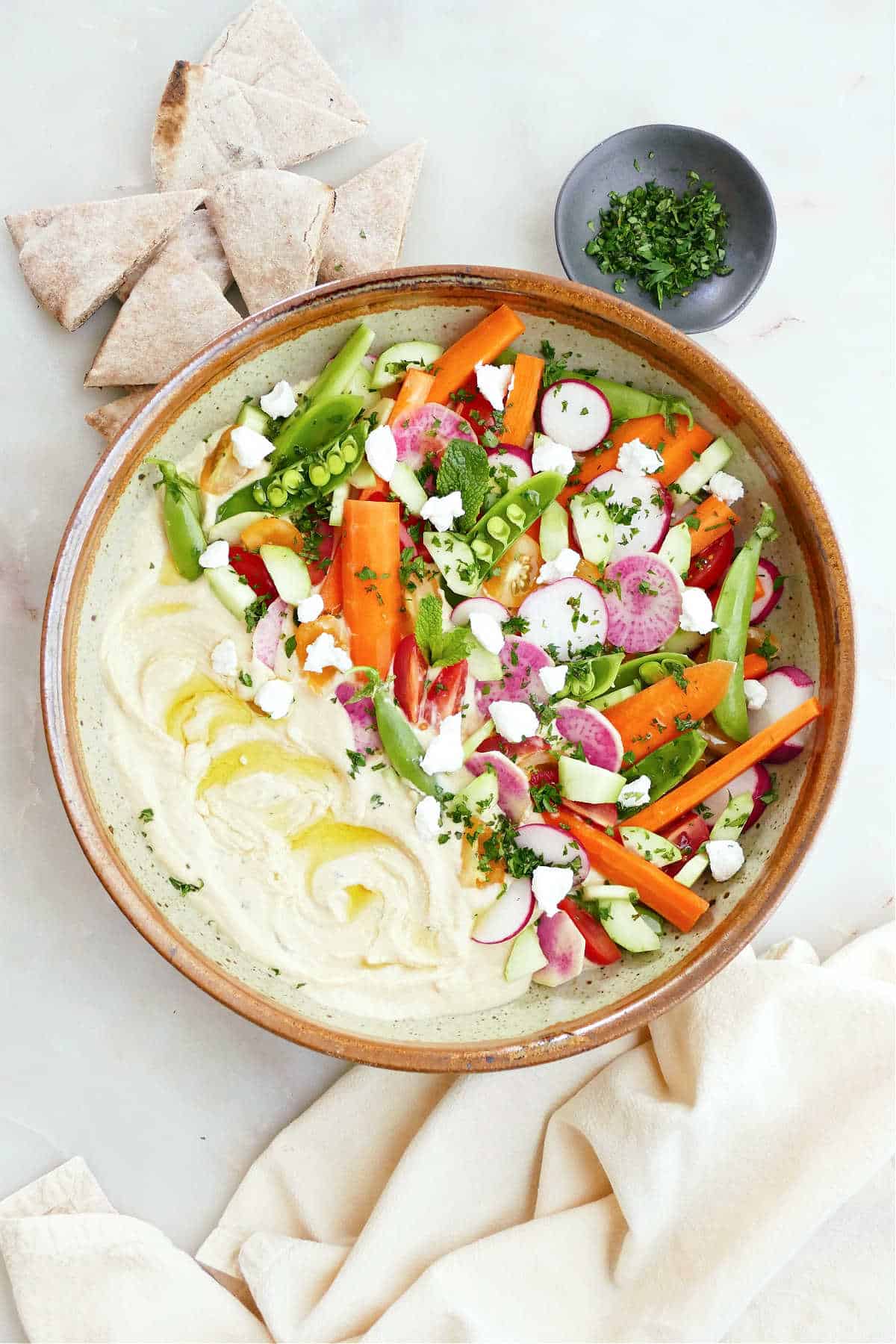
Jump to:
Lizzie’s Notes
A couple of years ago, my mom started making a beautiful hummus platter anytime she hosted a holiday or gathering. She spreads hummus on a dish and then sprinkles it with Mediterranean-inspired toppings like fresh tomatoes, cucumbers, and feta cheese. It’s always a huge hit!
As I look forward to spring and summer entertaining, I’ve been working on perfecting my own version of my mom’s hummus appetizer to share with all of you. I finally nailed the process of picking the most vibrant combination of vegetables and herbs and making the creamiest homemade hummus. So, I’m spilling it all in the sections that follow!
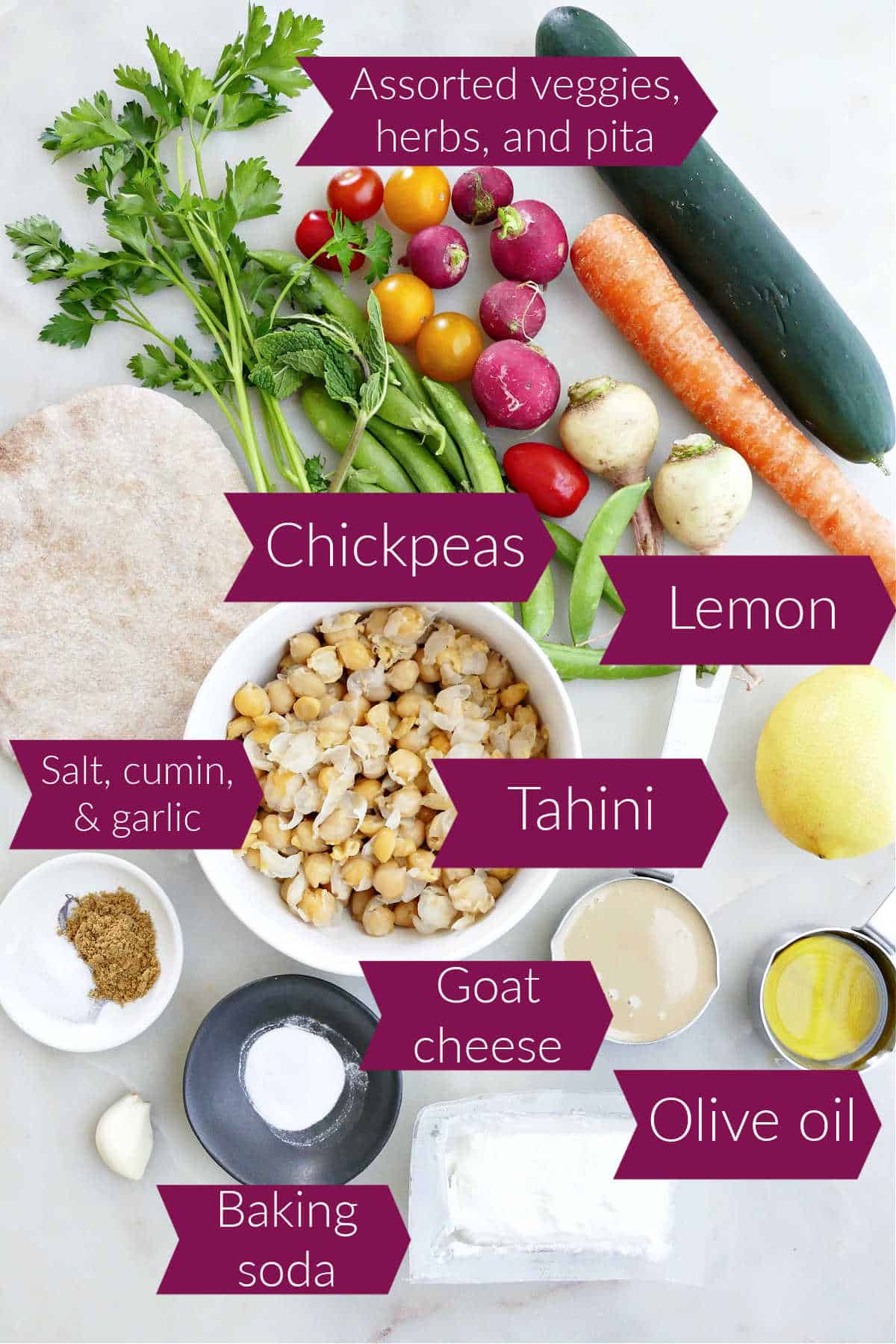
Ingredients and Substitutions
- Chickpeas: Use canned or cooked chickpeas for homemade hummus. One can has about 1 and ½ cups of drained chickpeas.
- Baking soda: Cooking chickpeas with baking soda makes them very soft for blending. I explain why in the following section.
- Tahini: Sesame seed paste is a key ingredient in hummus. My favorite brands are Mighty Sesame Co., Trader Joe’s, and Soom.
- Lemon juice: Use apple cider vinegar if you’re out of lemons.
- Garlic: Fresh garlic adds a great kick, but you could use dried minced garlic if that’s all you have.
- Salt and ground cumin: You can omit the cumin, but I think it adds awesome flavor.
- Extra virgin olive oil: Use a high-quality olive oil, such as Partanna.
- Assorted vegetables and herbs: Carrots, cucumbers, cherry tomatoes, radishes, snap peas, parsley, and mint are some of my favorite choices for a hummus platter!
- Pita: You can warm up pita bread and slice it into triangles or use pita chips. Baguette slices also work.
- Crumbled goat or feta cheese: Omit if you want a vegan appetizer.
Tips for Making Creamy Hummus
When making a hummus platter, you can totally use store-bought hummus if you want. Skip past this section if that’s what you would like to do. If you want to make homemade hummus, follow these tips for making the creamiest, dreamiest dip:
- Equipment: Use a food processor with the S-blade or a high-powered blender to make homemade hummus. I use a Cuisinart 11-cup food processor.
- Chickpeas and baking soda: If you want to make creamy hummus similar to the kind you would get at a restaurant, consider boiling the chickpeas with baking soda first. This is a tip that’s used by a lot of chefs, including Mike Solomonov of Philadelphia’s renowned Zahav restaurant. The baking soda increases the pH of the water, which helps break down bonds within the chickpeas that hold them together. As a result, they get very soft and can then be blended into a very smooth consistency (which is what you want for hummus)! A lot of hummus recipes call for cooking dried chickpeas from scratch with baking soda, but you can do it with canned chickpeas and save a lot of time. Put a can of drained chickpeas in a saucepan, then add ½ teaspoon baking soda and enough water to cover them by a couple of inches. Boil them for 20 minutes, drain, and rinse.
- Tahini: Homemade hummus aficionados recommend using tahini made with sesame seeds from Ethiopia, especially Humera seeds, that have a high fat content and great flavor. Soom and Mighty Sesame Co. tahini are made with Ethiopian seeds and have a really smooth texture without any bitter taste IMO. There are more great tahini brands out there too. You may need to try a few to see which one you like best.
- Ice water: Another tip from hummus experts, including Zahav’s chef, is using ice water throughout the process to emulsify the tahini and chickpeas so that the ingredients don’t separate. This leads to an extremely smooth, almost fluffy texture.
Topping Ideas and Variations
When arranging a hummus platter, follow these tips to create a visually stimulating and beautiful presentation:
- Use a variety of colorful vegetables in different shapes and sizes. Include some classics, like carrots, cucumbers, peppers, and tomatoes, alongside options you don’t always see on appetizer boards. I like to add thin slices of regular and watermelon radishes, snap peas (sliced in half lengthwise to expose the peas in the shell), purple or yellow cauliflower florets, blanched green beans, jicama sticks, or long broccolini stalks.
- Consider cooked vegetables instead. Roasted or blanched vegetables are a great option for hummus plates if you’re looking for something different. Blanched green beans and asparagus are fun for the spring, while roasted root vegetables like baby potatoes, parsnips, beets, turnips, and carrots are good for winter. In the summer, consider roasting zucchini, tomatoes, red onion, and bell peppers to spread on top of hummus with goat cheese and fresh mint.
- Add fresh herbs or even edible flowers. I love mint, parsley, and basil on hummus. Rosemary or thyme are great choices if you use root vegetables. If you can find edible flowers like pansies, they’re a beautiful addition!
- Include something salty, crunchy, or sweet. If you want to mix it up, add olives, nuts or seeds, or fresh or dried fruit.
- Serve the toppings right on the hummus or separately. I love to make my hummus platter look like a garden and serve the vegetables sitting right on top of the hummus, usually just on one side of the platter or bowl. That way, people have the option to scoop up hummus from the side without toppings if they just want to eat it with pita. You can also put the hummus in a large bowl or a few small bowls and arrange the veggies and other dippers around them.
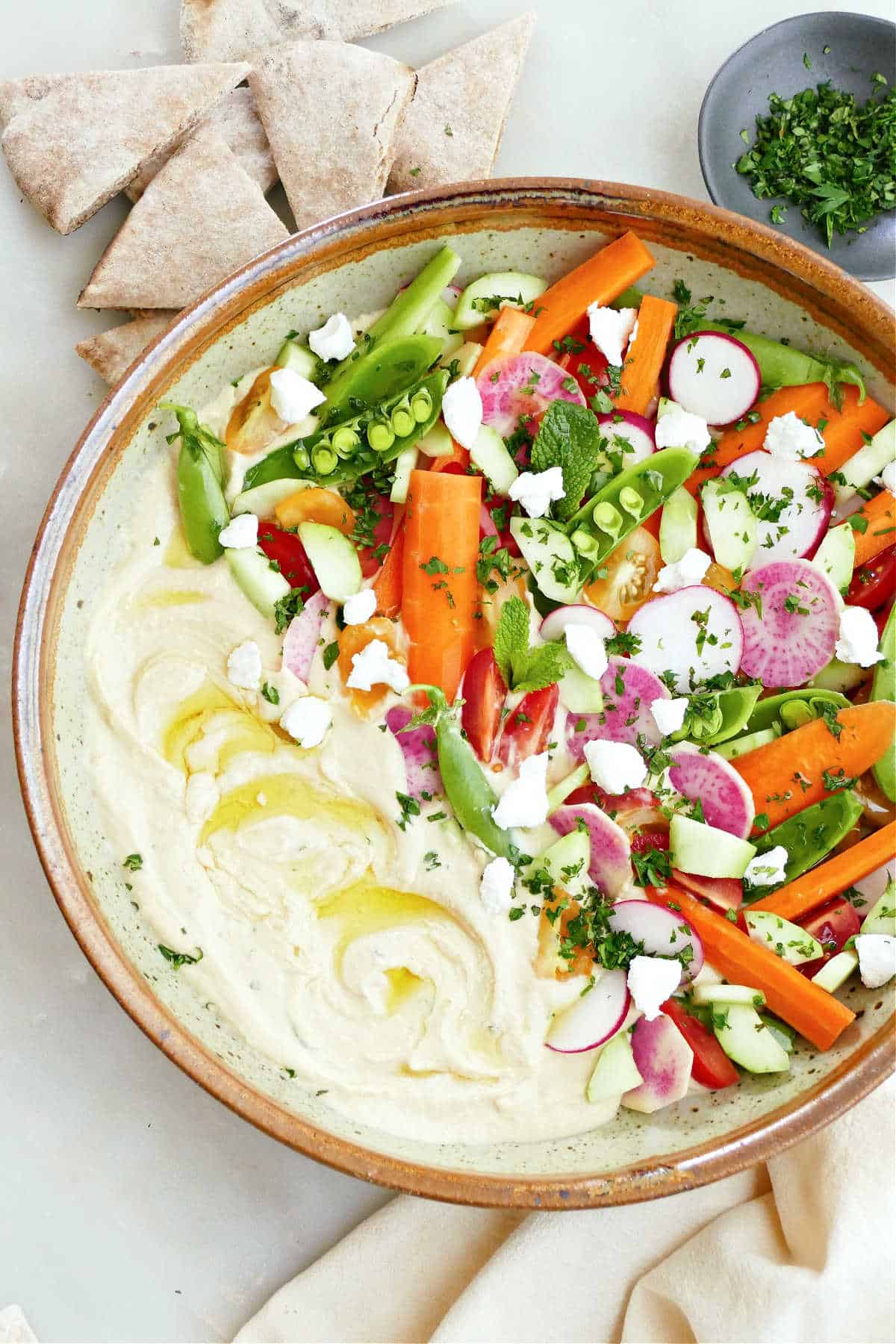
Storage and Make Ahead
Hummus platters can be made ahead of time if needed. You can make hummus up to a few days in advance. Store it in an airtight container until you are ready to assemble the appetizer board. Once assembled, cover tightly with plastic wrap. Keep in the refrigerator for up to 8 to 12 hours until serving.
More Appetizer Recipes
If you’re inspired by this hummus platter, check out these other posts while you’re here:
📖 Recipe
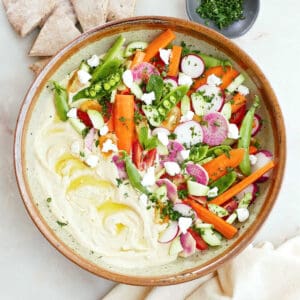
Hummus Platter with Vegetables
Equipment
- Food processor (or high-powered blender, if making homemade hummus)
- Serving platter
Ingredients
Homemade hummus (can sub store-bought)
- 15 ounces chickpeas - drained and rinsed, or 1.5 cups cooked chickpeas
- ½ teaspoon baking soda
- ⅓ to ½ cup tahini
- 1 medium clove garlic
- 2 to 4 tablespoons lemon juice - from ½ to 1 medium lemon
- 3 tablespoons extra virgin olive oil
- 3 tablespoons ice water - more as needed
- 1 teaspoon cumin
- ½ teaspoon salt
Toppings
- 3 small radishes - thinly sliced
- 2 small watermelon radishes - thinly sliced
- ½ large cucumber - peeled and cut into pieces of desired size
- 2 large carrots - peeled and cut into pieces of desired size
- 1 cup cherry tomatoes - cut into quarters
- 1 cup sugar snap peas
- 2 tablespoons chopped fresh parsley
- 2 tablespoons chopped fresh mint
- 3 tablespoons crumbled goat cheese - or feta
- Extra virgin olive oil - for drizzling
- 4 whole wheat pita - warmed and sliced into triangles
Instructions
- If you want to make homemade hummus, add the drained chickpeas to a saucepan with the baking soda and enough water to cover them by about 2 inches. Bring to a boil, reduce heat to maintain a boil but prevent overflow (if needed), and boil for 20 minutes. Drain and rinse. The chickpeas should be very soft and easily mushed between your fingers.
- In a food processor fitted with the S-blade or a high-powered blender, combine the tahini, lemon juice, garlic clove, and olive oil. Use a full ½ cup of tahini if you really like that flavor and ⅓ cup if you don't want as much. Blend until the garlic is pulverized and the ingredients are well-combined, about 1 to 2 minutes.
- While the food processor is running, pour the ice water through the hole in the top. It will make the consistency of the hummus a little fluffier.
- Stop the food processor, scraping down the sides as needed. Then add the chickpeas, cumin, and salt. Blend again for 1 to 2 minutes until the hummus is extremely smooth. Add more ice water, 1 tablespoon at a time, to thin and make it fluffier and creamier if needed. Taste and adjust seasonings, adding more lemon juice and salt if desired.
- Spoon the hummus onto a serving platter, spreading it with the back of your spoon.
- Arrange your hummus platter by nestling and sprinkling the vegetables on the hummus. Sprinkle the herbs and feta cheese on top, then drizzle everything with olive oil. Finally, put the pita rounds in a bowl outside the platter. I like to put the veggies right on top of the hummus on the platter and leave a little less than half of the hummus without toppings. That way, if people just want plain hummus to eat with pita, they can still access it.
- Serve, and enjoy! If you need to prep it ahead of time, wrap tightly with plastic wrap and keep in the fridge for up to 8 to 12 hours before serving.
- Leave a rating or review by tapping the stars on this recipe card (above) or in the comments section (at the end of the post)!
Notes
- For different variations, consider using roasted vegetables instead of raw.
- Blanched green beans and asparagus for spring
- Roasted tomatoes, peppers, zucchini, and red onion for summer
- Potatoes, beets, carrots, fennel, and parsnips for fall and winter

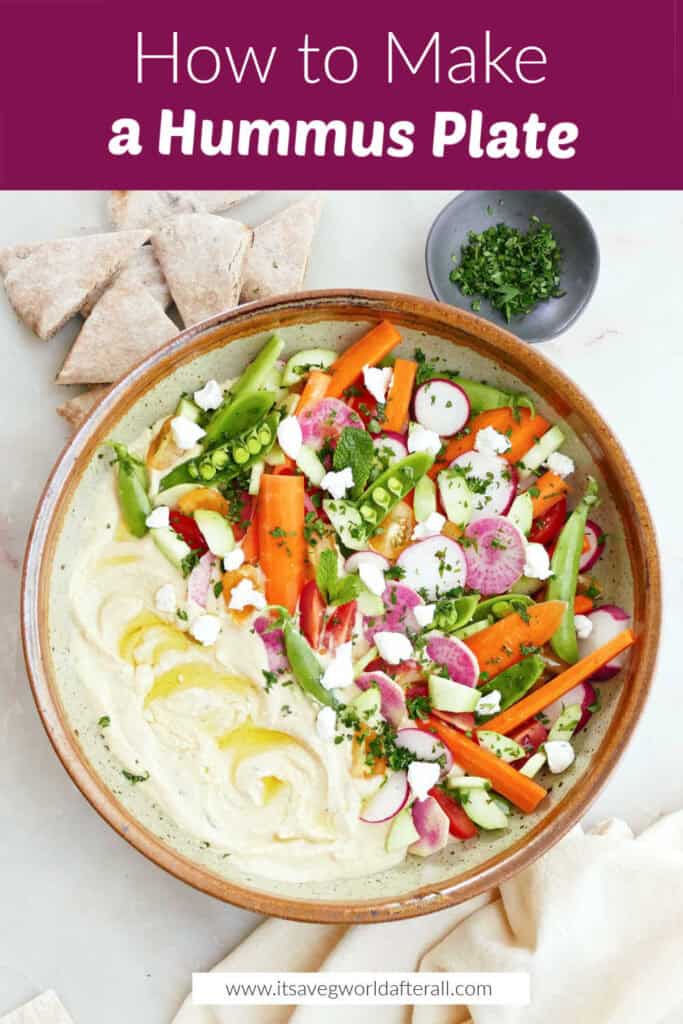
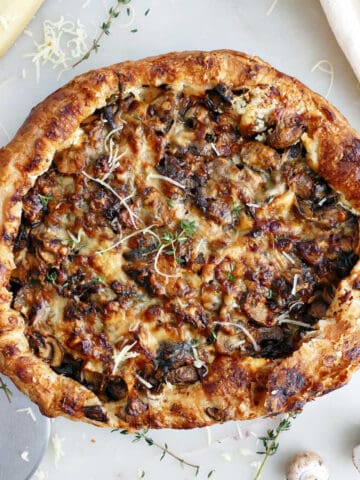
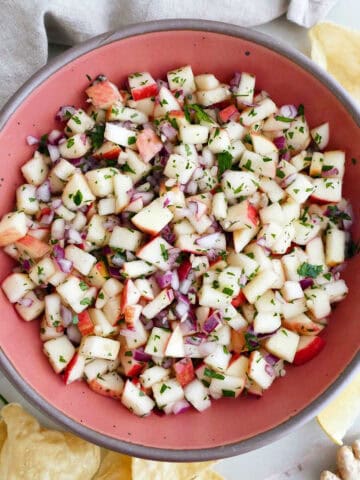
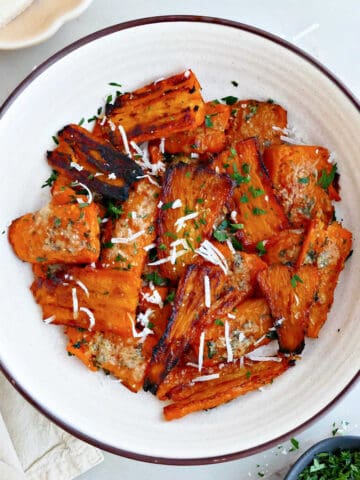
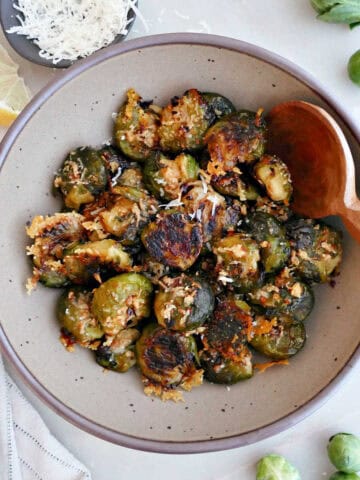
Comments
No Comments